Here are a list of Historical Towers In Ireland.
Kilmacduagh Round Tower 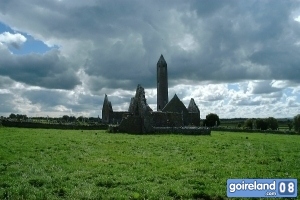
The ruins of Kilmacduagh Monastic Settlement lie close to the border of counties Galway and Clare, on the eastern fringes of the Burren. because it is somewhat off the beaten track, it tends to be rather unjustly overlooked as one of the most interesting examples of early monastic architecture in the west of Ireland.
The monastery’s most notable feature is the 11th/12th century Round Tower measuring 111ft to the tip of its cap. The tower is unusual in that it tilts, like its more famous countrerpart at Pisa, which was built some centuries later. Below the tower are the ruins of a small cathedral which contain two finely carved crucifixions.
Scattery Round Tower and Churches 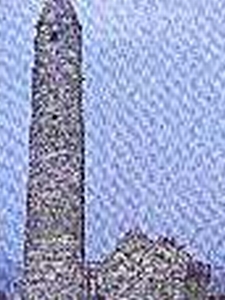
The island of Scattery is just off the small port of Kilrush, County Clare. The monastery on the island was founded in the 6th century by St. Senan, who like, St. Kevin of Glendalough, had a notorious dislike of women! One of his pupils was St. Ciaran of Clonmacnois. It was attacked and looted by the Vikings in 816 and 835 and it is thought the Vikings occupied the monastery from 972 to 975, but were captured by Brian Boru. The most distinguishing characteristic of the monastery is the 120 foot round tower, which surprisingly has a door on ground level.
Doors were usually several feet off the ground. The church of the Hill of the Angel is south - west of the round tower. The legend connected with this church tells that an Angel placed St. Senan on the hill, as he was about to fight a horrible monster. St. Senan won the fight and killed it. The monastery remained important up until the15th century, but was destroyed by Elizabethan troops.
Thoor Ballylee Castle, Gort 
Thoor Ballylee Castle is a four storey tower dating back to the 16th century, beautifully situated beside a stream. There was much to enchant William Butler Yeats on his first visit to Ballylee in 1885: the old square castle, the little river and the legend of a most beautiful local woman ‘Mary Hynes, the Shining Flower of Ballylee.
He eventually bought the medieval tower, which was built by the Norman de Burgo family, with a cottage and garden for the grand sum of IR35.00 in 1916. The following year he married Miss George Hyde-Lees, and two years were spent restoring the ‘Thoor’ before they could live there. Yeats particularly liked the juxtaposition of the noble castle and humble cottage.
For a number of years the tower became Yeats’ monument and symbol and featured in the title and cover illustration of his 1928 book ‘The Tower’, inspired by Ballylee.
All was in ruin once again shortly after Yeats left it in 1929, but in 1965 it was restored as a Yeats museum, and now contains an interesting collection of first editions of the poet’s works.
Antrim Round Tower 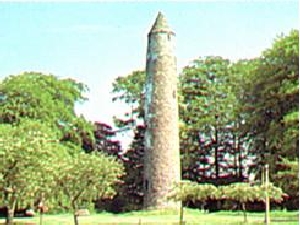
A well-preserved Round Tower, which stands to a height of 92 feet, though the conical cap was reset after the tower was struck by lightening in 1819. It has one unique feature: a ringed cross carved in relief on a stone above the lintel of the doorway on the north-eastern portion of the tower. The cross does not help us to date the tower which, however, is likely to have been built in the 10th or 11th century. Together with a large bullaun stone nearby, it is the only monumental survivor of a monastery founded perhaps by St. Comgall of Bangor in the 6th century.
It’s located in the grounds of the Antrim Borough Council offices.
Round Tower, Glendalough 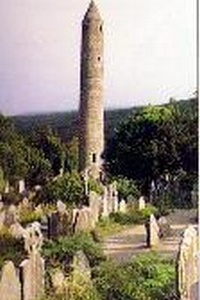
For many, Round towers have come to be seen as a symbol of Ireland and a direct link with the glories of the monastic era. The Glendalough Round Tower is probably the finest surviving example in Ireland. Over 40 metres in height and with a circumference of 16 metres, access is through a doorway 3.5 metres above ground. Built for the dual purposes of serving as a watch-tower and place of refuge during the period of the Viking invasions, the tower was restored in 1876, the conical cap being rebuilt with the original stones which were found scattered at the base.
The Rock Of Cashel 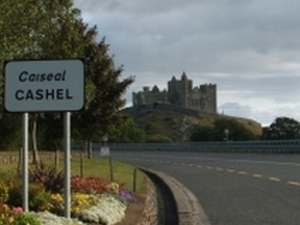
A spectacular group of medieval buildings set on an outcrop of limestone in the Golden Vale including the 12th century round tower, High Cross and Romanesque Chapel, 13th century Gothic cathedral, 15th century castle and the restored Hall of the Vicars.
Features include an audio visual show entitled “Strongholds of Faith”, which is available in English, French, Italian and German as well as various other exhibitions.
Please note that this is a very busy site and visitors may experience a delay during the summer months. Here are the opening times for the centre:
Mid September - Mid October, Daily 9am - 5.30pm
Mid October - Mid March, Daily 9am - 4.30pm
Mid March - Early June, Daily, 9am - 5.30
Early June - Mid September, Daily, 9am - 7pm
Turlough Round Tower, Mayo 
A well-preserved round Tower which is lower and fatter than most examples. It had a round-headed doorway (now blocked up), and flat - and gable-headed windows. The church beside it, although built in the 18th century, incorporates a 16th century mullioned window and a small plaque with the Crucifixion dated 1625. The first church here was founded by St. Patrick and, because of this, the Archbishops of Armagh long claimed jurisdiction over it. But in 1351 the Pope authorised the Archbishop of Armagh to relinquish his rights over it to the Archbishop of Tuam. After the Dissolution it passed to the Bourkes, but some time after 1655 it came into the ownership of the Fitzgerald family.
Lusk Round Tower 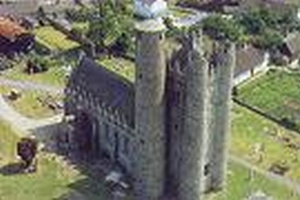
Lusk Round Tower is all that remains of a monastery, founded in the 6th century by St Macculin.
The attached tower house is of the 16th century origin and contains the Lusk Heritage Centre (see separate record) where there is an interesting exhibition of Fingals medieval churches and a 16th century effigy tomb.
Waterford Church And Round Tower 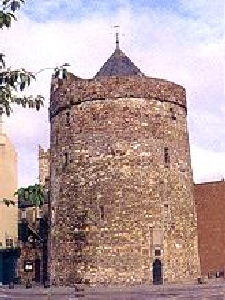
Waterford was founded by the Vikings around 914 and initiated its own episcopal See in the 11th century. It was taken by Diarmuid Mac Murrough Kavanagh, and later fell to Strongbow who married MacMurrough’s daughter in the now no longer existing Cathedral in the town. In medieval times it was a flourishing port, loyal to the English crown. However, it lost status by remaining Catholic, and submitted to Cromwell’s son-in-law in 1650. In the 18th and early 19th century, the town had a famous glass industry which was re-established in 1947.
The French church was founded as a convent for the Franciscans by Hugh Purcell about 1240. In 1395 the O’Conor Don, de Burgo, O’Brien and O’Kennedy submitted to Richard 11 in the Friary, and Cahpters of the Order were held here in 1317, 1469, 1615 and 1834. Of the original buildings a nave, chancel and north aisle remain. There is a triple-light east window in the chancel. In 1545 Henry Walsh was granted a charter by Henry V!!! to make the Friary, by then dissolved, into a hospital, and the area over the nave of the church was used as such for hundreds of years, while the chancel and the Lady Chapel were used for the burials of members of illustrious Waterford families such as the Powers, Waddings etc. Reginald’s Tower: The tower was allegedly founded by Reginald the Dane in 1003, but it is probably a 13th century Norman tower.
